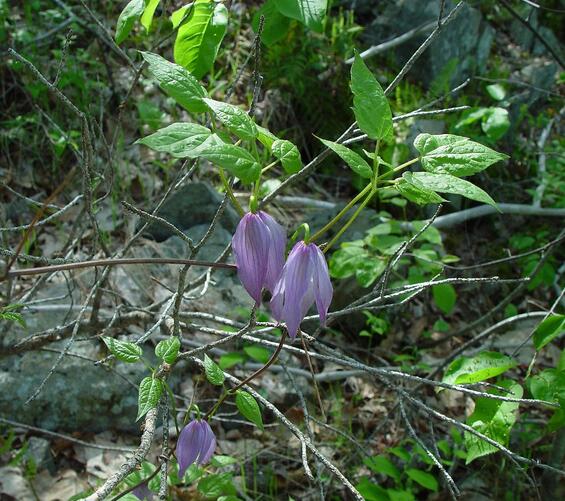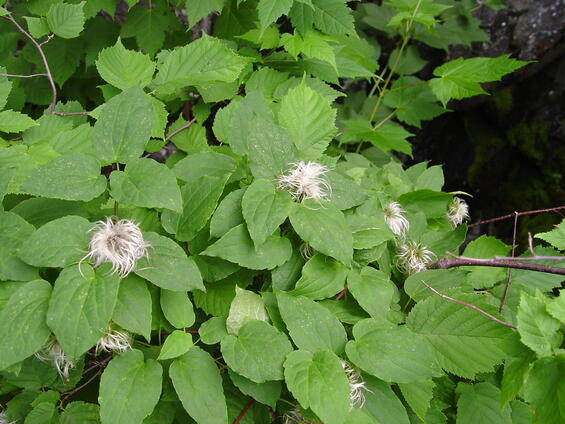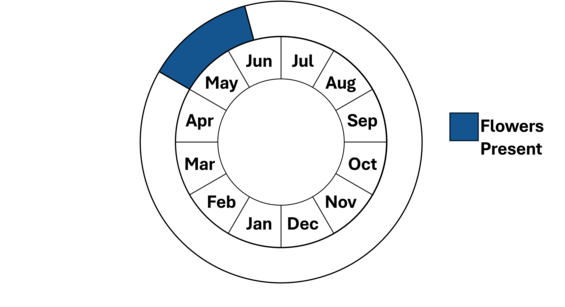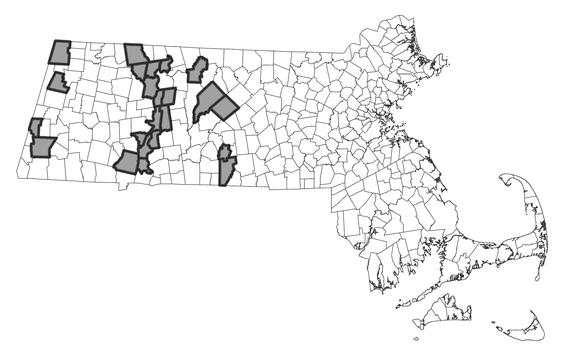- Scientific name: Clematis occidentalis (Hornem.) DC.
- Species of Greatest Conservation Need (MA State Wildlife Action Plan)
- Special Concern (MA Endangered Species Act)
Description
Purple clematis (Clematis occidentalis) is a graceful, woody vine of sub-acid rocky slopes and outcrops. A member of the buttercup family (Ranunculaceae), it has opposite or whorled leaves and pendant bluish or purple flowers that bloom from May to June. Purple clematis has a trailing or climbing stem that grows to a length of 2 m (6 ft). The leaves are opposite or whorled, and compound with three long-stalked leaflets. The leaflets are egg shaped (ovate) and may be slightly toothed or entire. They are about 4-7.5 cm (1.6-3 in) long, and 2.5-5 cm (1-2 in) wide. The flowers originate from the leaf axils, are solitary, and have four bluish to purplish petaloid sepals. The sepals are about 3.5 cm (1.4 in) in length. The fruit is an achene (dry, one-seeded), and forms within a dense, conspicuous feathery head from July to September.
Purple clematis most resembles the virgin’s bower (Clematis virginiana). However, this species has white flowers within a panicle (a branched cluster of flowers) originating from the leaf axils, rather than solitary, purple flowers. Also, the leaflets of virgin’s bower are coarsely toothed, while those of purple clematis are entire to irregularly lobed.
Autumn clematis (Clematis terniflora), an introduced species with invasive tendencies, and other horticultural purple clematis might be mistaken as purple clematis. Autumn clematis has divided leaves with 3 or 5 leaflets with entire margins, and prolific white flowers in the fall. Many of the horticultural varieties have purple petal-like sepals like purple clematis, but have many more than 4 bluish purple sepals and the flowers are showy, not drooping and bloom later in the season then purple clematis. Some of these have leaves divided into leaflets, while others have undivided leaves.

Clematis occidentalis in bloom. Photo by Arthur Haines Native Plant Trust

Clematis occidentalis in seed. Photo by Don Cameron
Life cycle and behavior

Purple clematis is a perennial species. It has has pendant bluish or purple flowers that bloom from May to June. Seeds are spread by wind later in the summer via fluffy extensions on the seeds.
Population status
Purple clematis is listed under the Massachusetts Endangered Species Act as a species of Special Concern. All listed species are legally protected from killing, collection, possession, or sale, and from activities that would destroy habitat and thus directly or indirectly cause mortality or disrupt critical behaviors. Purple clematis has 38 populations verified since 1999 from Berkshire, Franklin, Hampden, Hampshire, and Worcester Counties, and is historically known from Middlesex County. Most populations consist of only a few plants.
Distribution and abundance
The range of purple clematis is broad, covering much of northern North America. It is divided into at least three populations with a division between them running from Manitoba, the Dakotas and south, where no purple clematis occurs. The eastern states support Clematis occidentalis var. occidentalis. Its range extends from Nova Scotia to Ontario and south to Iowa and North Carolina. It is rare in many of the coastal and southern states. In New England, purple clematis is critically imperiled in Rhode Island, imperiled in Massachusetts, vulnerable in Maine and Vermont and not assessed in Connecticut and New Hampshire (NatureServe 2025).

Distribution in Massachusetts
1999-2024
Based on records in the Natural Heritage Database
Habitat
Purple clematis inhabits mesic to dry, semi-shaded, steep areas of calcareous or circumneutral rocky outcrops, talus, and cliff areas. The vine trails along the ground on rocky slopes and ledges or climbs vertically on supporting trees and shrubs. Associated plant species include white ash (Fraxinus americana), sugar maple (Acer saccharum), wild columbine (Aquilegia canadensis), virginia creeper (Parthenocissus quinquefolia), and climbing fumitory (Adlumia fungosa, Special Concern).
Healthy habitats are vital for supporting native wildlife and plants. Explore habitats and learn about conservation and restoration in Massachusetts.
Threats
Purple clematis requires filtered sun exposure; therefore, forest maturation and canopy closure, resulting from a lack of natural or anthropogenic disturbance, may over-shade the plant. Invasive exotic plant species may over-shade or out-compete purple clematis at some sites. Habitats along trails may be threatened by trampling damage.
Conservation and management
As with many rare species, the exact management needs of purple clematis are not known. Sites should be monitored for over-shading caused by forest succession, and for invasive plant species. Habitat sites that do not receive enough light can be managed with canopy thinning or prescription burning. If trampling or erosion are threats in recreational areas, trails can be stabilized or re-routed. To avoid inadvertent harm to rare plants, all active management of rare plant populations (including invasive species removal) should be planned in consultation with MassWildlife’s Natural Heritage & Endangered Species Program.
References
NatureServe. 2025. NatureServe Network Biodiversity Location Data accessed through NatureServe Explorer [web application]. NatureServe, Arlington, Virginia. Available https://explorer.natureserve.org/. Accessed: 5/23/2025.
Contact
| Date published: | April 10, 2025 |
|---|